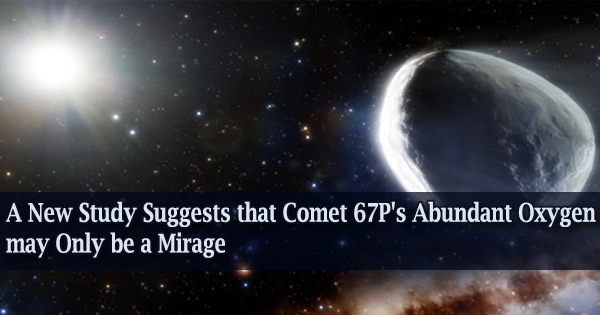Scientists were perplexed when the European Space Agency’s Rosetta probe saw a lot of molecular oxygen exploding from comet 67P/Churyumov-Gerasimenko (67P) in 2015. They had never observed a comet produce oxygen, much less so much of it.
The deeper ramifications, however, which required academics to reevaluate everything they had previously believed to be true about the chemistry of the early solar system and how it originated, were far more concerning.
Rosetta’s discovery may not be as anomalous as initially thought, according to a new analysis performed by planetary scientist Adrienn Luspay-Kuti at the Johns Hopkins Applied Physics Laboratory (APL) in Laurel, Maryland. Instead, it contends that the comet has two internal stores that artificially inflate the amount of oxygen present.
“It’s kind of an illusion,” Luspay-Kuti said. “In reality, the comet doesn’t have this high oxygen abundance, at least not as far as its formation goes, but it has accumulated oxygen that gets trapped in the upper layers of the comet, which then gets released all at once.”
Despite being widespread on Earth, molecular oxygen (two oxygen atoms joined together twice) is remarkably rare across the cosmos. Only a few molecular clouds contain significant concentrations of oxygen because oxygen quickly attaches to other atoms and molecules, particularly the universally common hydrogen and carbon atoms. Many scientists came to the conclusion that whatever oxygen present in the protosolar nebula that gave rise to our solar system had probably been similarly sucked out.
But everything changed when Rosetta discovered that comet 67P was spewing oxygen. Since oxygen had never been observed in a comet before and was the fourth most prevalent component (after water, carbon dioxide, and carbon monoxide) in the comet’s brilliant coma, an explanation was required.
Many scientists hypothesized that the oxygen was either primordial, which would suggest that it was bound up with water at the beginning of the solar system and accumulated in the comet when it subsequently developed, or that it was produced from water after the comet had already formed.
But Luspay-Kuti and her group had their doubts. The comet’s dumbbell form means that each “bell” (or hemisphere) faces the Sun at different times, indicating that the comet has seasons and that the oxygen-water connection may not always be there. Volatiles may potentially turn on and off over brief periods of time as they thaw and refreeze with the seasons.
It’s kind of an illusion. In reality, the comet doesn’t have this high oxygen abundance, at least not as far as its formation goes, but it has accumulated oxygen that gets trapped in the upper layers of the comet, which then gets released all at once.
Adrienn Luspay-Kuti
Now You See It, Now You Don’t
Utilizing these seasons, the researchers looked at the molecular data on short- and long-time intervals just before the southern hemisphere of the comet entered summer and then again just as its summer was coming to a close.
The scientists discovered that the relationship between oxygen and water vanished once the southern hemisphere turned away and was sufficiently far from the Sun, as detailed in their paper, which was published on March 10 in Nature Astronomy.
Since there was significantly less water leaving the comet, oxygen appeared to be strongly related to carbon dioxide and carbon monoxide, which the comet was still generating.
“There’s no way that should be possible under the previous explanations suggested,” Luspay-Kuti said. “If oxygen were primordial and tied to water in its formation, there shouldn’t be any time that oxygen strongly correlates with carbon monoxide and carbon dioxide but not water.”
The scientists instead postulated that the oxygen in the comet comes from two reservoirs, one deep under the comet’s stony nucleus made of oxygen, carbon monoxide, and carbon dioxide, and the other shallower and closer to the surface where oxygen chemically reacts with water ice molecules.
The theory goes as follows: Because oxygen, carbon dioxide, and carbon monoxide all evaporate at extremely low temperatures, a deep store of oxygen, carbon monoxide, and carbon dioxide ice is continuously leaking gases.
However, some oxygen chemically binds to water ice, a significant component of the comet’s nucleus, as it travels from the interior toward the surface, creating a second, shallower oxygen reservoir. However, water ice vaporizes at a considerably higher temperature than oxygen, thus the oxygen is trapped until the surface is sufficiently heated by the Sun to cause the water ice to evaporates.
As a result, oxygen can build up in this little reservoir for extended periods of time before the comet surface is ultimately warmed enough for water ice to melt, unleashing a plume that is far richer in oxygen than the comet itself was.
“Put another way, the oxygen abundances measured in the comet’s coma aren’t necessarily reflecting its abundances in the comet’s nucleus,” Luspay-Kuti explained.
In line with what Rosetta observed, the comet would therefore fluctuate with the seasons between strongly associating with water (when the Sun heats the surface) and strongly associating with carbon dioxide and carbon monoxide (when that surface faces away from the Sun and the comet is sufficiently far).
“This isn’t just one explanation: It’s the explanation because there is no other possibility,” said Olivier Mousis, a planetary scientist from France’s Aix-Marseille Université and a study co-author. “If oxygen were just coming from the surface, you wouldn’t see these trends observed by Rosetta.”
The main implication, according to him, is that comet 67P’s oxygen actually came from accretion at the start of the solar system. Just a small portion of what they had anticipated.
Examining the small molecular species of the comet, such as methane and ethane, and their relationships with molecular oxygen and other important species, according to Luspay-Kuti, will allow her to delve deeper into the subject. She believes that by doing this, scientists will be able to identify the kind of ice that the oxygen was absorbed into.
“You still have to come up with a way to incorporate the oxygen into the comet,” Luspay-Kuti said, considering that the amount of oxygen is still higher than seen in most molecular clouds. She did, however, predict that the majority of researchers would breathe a sigh of relief upon hearing about the study’s findings.
















